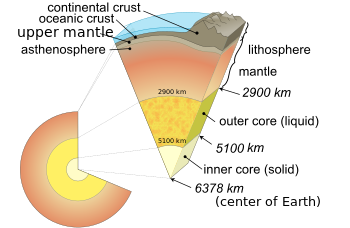
The subcontinental lithospheric mantle (SCLM) is the uppermost solid part of Earth's mantle associated with the continental lithosphere.
The modern understanding of the Earth's upper mantle is that there are two distinct components - the lithospheric part and the asthenosphere. The lithosphere, which includes the continental plates, acts as a brittle solid whereas the asthenosphere is hotter and weaker due to mantle convection. The boundary between these two layers is rheologically based and is not necessarily a strict function of depth. Specifically, oceanic lithosphere (lithosphere underneath the oceanic plates) and subcontinental lithosphere, is defined as a mechanical boundary layer that heats via conduction and the asthenosphere is a convecting adiabatic layer. In contrast to oceanic lithosphere, which experiences quicker rates of recycling, subcontinental lithosphere is chemically distinct, cold, and older. This translated into the differences between the SCLM and the oceanic lithospheric mantle.
There are two different types of subcontinental lithosphere that formed at different times in Earth's history: Archean and Phanerozoic subcontinental mantle.